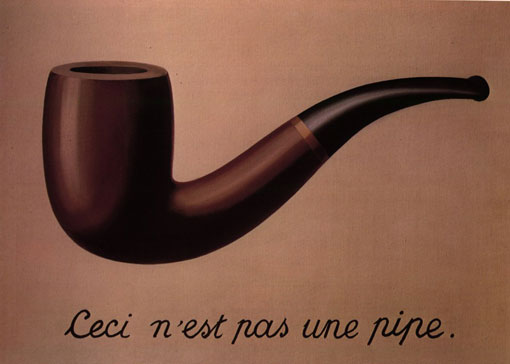|
Class assignment 1 (pair work, done orally):
Consider the sets of pictures below and suggest your ideas of their relationship with reality.
set 1, set 2,
set 3.
Class assignment 2 (group work, done orally):
First look at the pictures and read the commentaries and explanations inspired by them. Then perform the task below.
The Belgian surrealist Rene Magritte (1898-1967) painted La Trahison des Images
(The Treachery of Images) in 1936. It depicts a side-on view of a smoker's pipe and the
text 'Ceci n'est pas une pipe' ('This is not a pipe').

 The image provided here (Chandler, Daniel. Semiotics for Beginners. ) is similar but the text is different - this is not a reproduction of Magritte's painting(!). Both examples - Magritte's painting and this version - give us pause for thought. Each 'realistically' depicts an object which we easily recognize.
To depict a pipe and then provide a label which insists that 'this is not a pipe' initially seems perverse. Is it purely irrational or is there something which we can learn from this apparent paradox? What could it mean? As our minds struggle to find a stable, meaningful interpretation we may not be too happy that there is no single, 'correct' answer to this question - although those of us who are relatively 'tolerant of ambiguity' may accept that it offers a great deal of food for thought about levels (or modes) of reality. The indexical word 'this' can be seen as a key to the interpretation of this painting: what exactly does the word 'this' refer to? Anthony Wilden suggests several alternative interpretations:
The image provided here (Chandler, Daniel. Semiotics for Beginners. ) is similar but the text is different - this is not a reproduction of Magritte's painting(!). Both examples - Magritte's painting and this version - give us pause for thought. Each 'realistically' depicts an object which we easily recognize.
To depict a pipe and then provide a label which insists that 'this is not a pipe' initially seems perverse. Is it purely irrational or is there something which we can learn from this apparent paradox? What could it mean? As our minds struggle to find a stable, meaningful interpretation we may not be too happy that there is no single, 'correct' answer to this question - although those of us who are relatively 'tolerant of ambiguity' may accept that it offers a great deal of food for thought about levels (or modes) of reality. The indexical word 'this' can be seen as a key to the interpretation of this painting: what exactly does the word 'this' refer to? Anthony Wilden suggests several alternative interpretations:
- this [pipe] is not a pipe;
- this [image of a pipe] is not a pipe;
- this [painting] is not a pipe;
- this [sentence] is not a pipe;
- [this] this is not a pipe;
- [this] is not a pipe.
(Wilden 1987, 245)
The Task
Study the pictures and discuss whether they might be similar in their representation of reality with the one of Magritte's painting. If not, what kind of reality representation do they bear?
In your reasoning make use of D.Chandler's quotation:"Semiotics helps us to not to take representations for granted as 'reflections of reality', enabling us to take them apart and consider whose realities they represent."
set 1, set 2, set 3, set 4 (separate picture).
Class assignment 3 (group work, done orally):
Look at the pictures and try to figure out why they are classified as "empty", or "free-floating", signifiers.
|